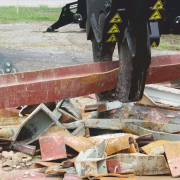Super-rapid Market Insights Using Satellite Technology
At the BIR Ferrous Division’s latest session on May 28, guest speaker Atilla Widnell invited his audience into the fascinating and ultra-modern world of end-to-end supply chain monitoring from space.
The Managing Director of Singapore-based Navigate Commodities explained how his company was using powerful satellite-based technologies to track everything from smelter activity and asset development to stockpiles and movements of short-/deep-sea vessels as well as barges. It was possible, for example, to “zoom out” to acquire a national consumption picture and to identify from where material flows were being pulled.
Updates every four hours enabled users to make strategic decisions closer to real time, according to Mr Widnell. “Our data tends to lead customs data,” the speaker observed, adding that the information performed “incredibly well” against industry benchmarks.
Among the insights offered by Mr Widnell to the meeting in Copenhagen, he pointed to a sharp drop in Turkey’s EAF activity over recent months. He also noted that, since the start of the Red Sea crisis, the number of vessels using the Suez Canal had fallen from typically 80 per day to nearer 40.
In other market observations, he indicated that recycled steel generation should be slowly improving in most parts of the developed world and that a “terrible” domestic market for steel in China had put the country on a course to record annual steel exports of more than 100 million tonnes this year for the first time since 2016.
The technology described by Mr Widnell dominated the subsequent panel discussion moderated by BIR Ferrous Division President Shane Mellor of UK-based Mellor Metals Ltd, who was accompanied on stage by: George Adams of SA Recycling in the USA; Denis Reuter of TSR Recycling GmbH & Co. KG, Zentrale in Germany; Mogens Christensen of HJ Hansen Recycling Group A/S in Denmark; and Alton Scott Newell III of Newell Recycling Equipment in the USA.
In response to a question from Mr Reuter about the precision of the technology, Mr Widnell contended that “you’re never going to be able to get 100% accuracy” and that he would expect a 10-15% margin of error. Everyone from the recycling industry who had seen the technology was “very receptive” to it, he added.
The Ferrous Division meeting in Copenhagen also featured the release of the fifteenth edition of “World Steel Recycling in Figures”. Identifying some of the publication’s highlights, Statistics Advisor Rolf Willeke confirmed that recycled steel usage across key countries and regions dropped 12% in 2023 at 411.281 million tonnes despite a 0.2% increase in their total crude steel production to 1.555 billion tonnes. These figures represent verified data for 82.2% of global steelmaking.
China remained the world’s largest user of recycled steel although its total slid 0.8% year on year to 213.68 million tonnes, equating to a 21% share of its crude steel production. The recycled steel use share was as high as 86.3% in Turkey last year, although 2023 also brought a 10.1% drop in the country’s overseas recycled steel purchases to 18.775 million tonnes. However, this decline failed to dislodge Turkey from its long-held position as the world’s foremost recycled steel importer, with India in second place following a 40.4% increase to 11.760 million tonnes.
Once again, the leading recycled steel exporter in 2023 was the EU-27 following a 9.2% year-on-year increase to 19.219 million tonnes; the USA came next despite its overseas shipments dipping 6.9% to 16.264 million tonnes.
Source: BIR (Brussels, May 30, 2024)






